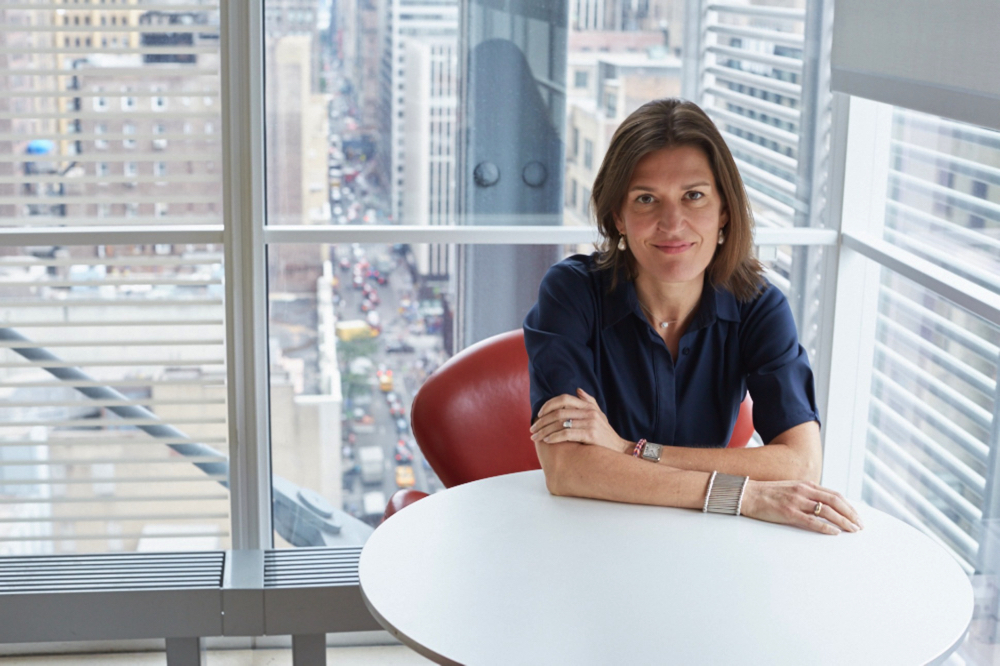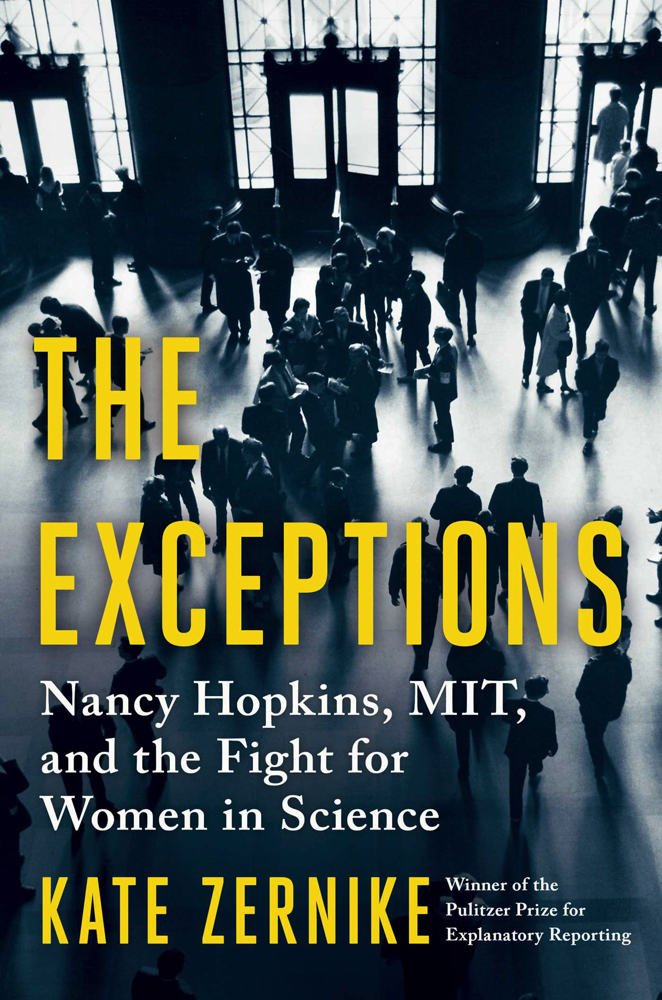In 1963, Radcliffe undergraduate Nancy Hopkins ’64, Ph.D. ’71, was struck by the elegance of the double helix. Seated in an introductory biology lecture on Divinity Avenue, she listened as her future mentor James Watson described the design of DNA, which had just earned him a Nobel Prize with Francis Crick. The simplicity and and beauty floored her—science could distill something as complicated as life to a set of rules. And in one clarifying instant, almost like a moment of conversion, Hopkins decided to devote her life to science.
Twenty years later Hopkins was a professor at MIT, a leading cancer researcher, and a pioneer in the use of zebrafish in the study of genetics—but she had to spend much of her time haggling with the MIT administration for enough lab space. After years of denying sexism as the reason colleagues took credit for her discoveries, sexually harassed her, or removed her from the successful biology course she’d designed, she finally had enough. She crawled around MIT’s labs late at night with a tape measure, calculating how her space compared to her male counterparts’. Everyone had more room than she did—even a male junior faculty member had double the square footage.
She delivered a letter, signed by 15 other female MIT scholars, to MIT’s dean of science Robert Birgeneau in 1994. It methodically outlined the many ways the institute had discriminated against female faculty and helped launched a formal committee report, published in 1999. The evidence was overwhelming, and in an unprecedented move, MIT admitted wrongdoing and accepted the findings. “I have always believed that contemporary gender discrimination within universities is part reality and part perception,” MIT president Chuck Vest wrote in the report’s introduction. “True, but I now understand that reality is by far the greater part of the balance.”
Hopkins again made waves in 2004 when she walked out of a speech by then-Harvard president Larry Summers on the lack of female representation in the sciences. Summers attributed the “very substantial disparities…with respect to the high-end scientific professions,” to what he believed may be “innate” differences. He suggested that the few women at the top of STEM fields were an exception to the rule: “intrinsic aptitudes” seemed to preclude women from the highest achievements in science and engineering. At “intrinsic aptitudes,” Hopkins left the room, a move for which she was both later celebrated and criticized.
The Exceptions: Nancy Hopkins, MIT, and the Fight for Women in Science by Kate Zernike, published this month, delivers an in-depth account of Hopkins’s life, research, and the moments that prompted her to collective action. New York Times reporter Zernike, who broke the story in 1999 at the Boston Globe, weaves information from interviews, Hopkins’s diaries, and Harvard’s archives to chart her subject’s course from accepter of the status quo to renegade.
Harvard Magazine met with Zernike to discuss Hopkins’s impact, the culture of women in STEM then and now, and the process of researching her book at Harvard. The interview has been edited for length and clarity.

Kate Zernike
Photograph courtesy of Harry Zernike
Harvard Magazine: You describe the many ways in which Nancy Hopkins was an unlikely leader of a women’s equality movement. She did not call herself a feminist at first and she was a firm believer that if she just worked hard enough, she could get where she wanted to go. How did her “unlikeliness” make her a successful leader?
Kate Zernike: Nancy really, really wanted to be a scientist. And she kept pushing against this nagging sense that maybe she wasn’t advancing because of her gender. In a Radcliffe Quarterly article, she wrote that the main setback [to a woman’s scientific career] was having children, and if women didn’t do that, they should be able to achieve what they wanted. But I think the fact that she had to be pushed so far to get to her breaking point, in some ways gave her the zeal of a convert. She started fighting and she was really determined about it. And when I first broke the story at the Globe, I was struck by how ingenious these women were. They went about collecting evidence [of discrimination] like scientists, using their natural curiosity to figure out the problem.
"Every generation thinks it’s solved the problem—and every generation discovers the problem anew."
HM: The book included in-depth research on what Harvard and Radcliffe were like in the 1960s when Nancy was a student. What was it like to be a female student interested in the sciences then?
KZ: One of the great things about writing about Harvard is that they record everything. My editors and I were talking about the first scene in the introductory bio class, where Nancy sees Jim Watson for the first time. One of the editors asked, “How many women were in the bio class?” And I was actually able to do some digging to find out, because Harvard keeps records of the courses taught. Then, I went down a rabbit hole of all the Radcliffe and Harvard records. I found the Radcliffe President’s report talking about how the number of women majoring in English and history had declined, and the number of women in sciences was going up.
So, you can see this generation before the women’s movement, and how it started to change. I looked at Nancy’s 1964 yearbook, the year she graduated from Radcliffe. It included essays from the yearbook editors where their attitude about Betty Friedan and The Second Sex was very much: We don’t need this. We’ve got this figured out. We’re going to have careers and have a family. It’ll be difficult, but we can do this. We’re the next generation.
It was so striking to me that when you go back and look, every generation thinks it’s solved the problem—and every generation discovers the problem anew.

HM: What beliefs and attitudes characterized these women coming of age on the cusp of the women’s movement?
KZ: I think the restrictions on them were stricter. Think about at Radcliffe. First of all, they were at Radcliffe, not Harvard. Secondly, they couldn’t come downstairs unless they were wearing a skirt after a certain hour. They had to wear a certain length of shorts to gym class in the Quad. There was a big debate about whether women and men could be in each other’s dorm rooms, which now seems like ancient history. Abortion was illegal, birth control was illegal in Massachusetts. The library [at Harvard] was closed to women.
And yet, women were stirring for change. You did see them moving away from traditional English and history majors. They were ambitious enough to try going into the sciences. In an essay for a 1963 American Academy of Arts and Sciences conference, Lotte Baiylan [who succeeded Lawrence Bacow as chair of the MIT faculty in 1997] wrote that, early in life, women have more choice than men. They could choose to go into a career or have a family or try to do both—whereas men at the time were expected to go into careers and didn’t have the same choice. But once women chose to go into the professional world, their choices were more limited.
HM: Why was this particular report so successful? Many previous reports on the status of women at other universities, like Harvard, had gone unnoticed.
KZ: I asked a lot of people this question in my research. And everyone agrees, it's because MIT president Chuck Vest put that statement on it, accepting the report. But the credit for the story still goes the women, because had they not banded together, had they not gathered this data, then Chuck Vest wouldn’t have made that statement.
"[Universities] opened the door to women, but they were just tolerating them—not welcoming them, not making them feel as though they belonged."
HM: Over and over throughout the book, the female scientists seem to blame themselves for the discrimination against them, assuming that perhaps interpersonal conflicts were the reasons they weren’t being promoted or their work respected. Why did so many of them blame themselves?
KZ: I think it's actually a function of numbers in a certain way, which is to say that there were so few women at MIT that if you spread them across the departments, they’re isolated. They don’t have a control group, so to speak. So, they think, “Well, the guys all seem to be getting along with each other. So, it must be something about me.” I also don’t think they wanted to explain it as a women’s problem, because there’s a certain frustration there. During my research, I talked to one female Harvard scientist who said, “Every time I have a problem, I assume that it’s 50 percent my responsibility, because then I can do something about it.”
But I think for the most part, there were so few women and they recognized that they had come in at a time when it was unlikely that women got jobs. So, they felt lucky to be there and they came in with an apologetic tone. The idea was, [universities] opened the door to women, but they were just tolerating them—not welcoming them, not making them feel as though they belonged.
HM: Hopkins, and many of the women you write about, spent so much time managing subtle forms of discrimination. For instance, colleagues would store extra equipment in their offices without asking, but never did that to male faculty. How do those small-scale acts add up?
KZ: One moment I loved [researching] is when Lotte Baiylan, now chair of the faculty, is trying to figure out a way to make the Academic Council—the highest administrative board at MIT—talk about the issue of how we treat women and how we treat underrepresented people. She brings in a handout with the first chapter of Virginia Valian’s book Why So Slow? And Valian talks about how yes, in isolation, these [small discriminatory acts] are molehills. When the acts are small, women don’t want to speak up and say they’re being discriminated against. But those molehills quickly become mountains.
I think in some ways, that’s the struggle that we have now. Now, there’s this sense that you can’t work within the system—you just have to burn the whole system down. I think there’s a conservative backlash where people say, “Well, they just complain about every little molehill.” So there is still this challenge of, how do you complain without being dismissed as a complainer? How do you bring attention to the problem without being thought of as a whiner?
"Molehills quickly become mountains."
HM: Your research involved interviewing women across fields. Did you interview women in different generations? Did you notice patterns between what has changed for women now and what has stayed the same?
KZ: I wanted to interview across fields and across generations and across races. The problems in the past were problems you could measure. The reason Nancy’s tape measure became famous is because there was a disparity in resources. Now, what a younger mathematician at MIT said to me was, “Anything they can measure, they can fix.” The problem is, how do you fix unconscious bias? That’s the constant thread through the generations. The National Academies of Sciences, Engineering, and Medicine released a poster that depicts bias as an iceberg. The iceberg you can see above the water includes discrimination like sexual coercion, sexual harassment, and sexual assault. What’s under the water, but still perilous, is the idea, whether overtly expressed or just hinted at, that women still don’t belong in this field. I’m especially interested by the work of [Princeton professor of philosophy] Sarah-Jane Leslie and [NYU professor of psychology] Andrei Cimpian. They’ve found that when we talk about the idea of “genius,” we tend to apply it to men far more often than we do to women.
One thing that women who were mid-career were saying was, the senior women call attention to issues and fix their problems. The younger women are being brought on because the men look at them like a daughter, and they want their own daughters to succeed, so they bring them along and support them. The trouble is mid-career, when men begin to see women as competitors, peers, or assume they’re established enough in their field that they don’t still need support or mentoring. The reality is, we need mentors at all stages of our careers—not just women, everyone.
HM: Six women, including Hopkins, first brought their complaints to MIT dean of science Robert Birgeneau. In the meeting, they all mentioned the sacrifices they’d made for their scientific careers, including that none of them had chosen to have children. How do you think that affected the conversation?
KZ: I think what made that conversation so powerful for the dean is he thought in that moment, “Wow, I have four kids.” He was thinking about the fact he hadn’t had to think about balancing work and life, he hadn’t had to think about how he’s going to have kids or not—he just did. It was expected that he’d get married, have kids and a career, but it wasn’t expected for these women. That was really powerful for him.
HM: What were the longstanding impacts of this report, and of Hopkins’s efforts?
KZ: First off, I think it signaled how important it was going to be to have women in top positions at universities. Other top schools, called “The MIT-9” [MIT, Harvard, Stanford, Caltech, Princeton, University of Pennsylvania, University of Michigan, Yale, and the University of California Berkeley] collaborated to study discrimination on their campuses. The National Science Foundation also launched the ADVANCE program to increase the representation and advancement of women in science and engineering. Now, seeing groups of women in science is much more common, much more a part of the landscape.
This report was a big moment. In the women’s movement, first you open the doors, and then you start making resources equal. One of the reasons this report was important was that it said, very visibly, [the disparities] that we can measure, we have to fix. It also raised awareness about unconscious bias.
"Science rewards sharp elbows, and women are expected to be nice."
HM: The book’s epilogue mentions former Harvard President Larry Summers’s now-infamous speech about women in science and engineering. Hopkins was so angered by the speech that she left in the middle. What does this moment with Summers signal about the progress that had been made, or hadn’t been made, for women in STEM?
KZ: Some of these episodes, like the one with Summers, can seem so extreme on their own, but then you put them all in context. It’s no wonder he said that, because society has been saying things like that for 100 years. One of his mistakes was thinking that what he was saying was new and contrarian and might provoke discussion. But no, all of that is the old argument.
HM: You’ve said science is a particularly hard field for women. Why is that? And how can people fix it?
KZ: I think academia is hard for women because of the pressure of the tenure clock. But within that, science is different, because in science, you can’t schedule discovery. If you’re doing an experiment, you don’t know when a breakthrough is going to happen. The expectation is that you’re going to work 80 hours a week. A young woman studying chemistry at Harvard told me about how people would leave a lab coat hanging up because they wanted other people to think they were in the lab. In science, you have to impress upon people how hard you’re working. There’s this real sense that if you’re not working 80 hours a week, you just don’t have what it takes.
Also, I think the expectations we have for women’s personalities are not compatible with certain scientific fields—in particular, math, computer science, and engineering. Science rewards sharp elbows, and women are expected to be nice. This whole idea that you need to be ambitious and aggressive enough to get your ideas out there, but you can’t be too aggressive, makes it hard for women.
But those are fixable, changeable problems. It’s not that it’s easy, but if we pay constant attention to this, instead of having to produce these reports every five years or 20 years, instead of having every generation have to recognize this problem, if we can keep our eye on that ball and remember that [unconscious bias] is something that we all have to check ourselves on, that will go a long way.









